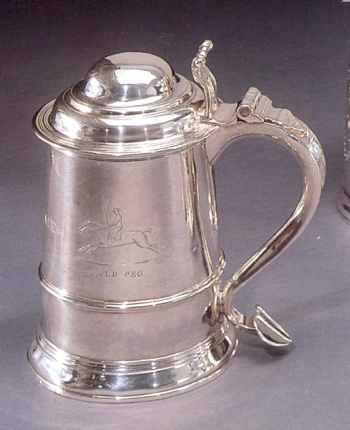|
TANKARD
Originally the name "tankard" meant a vessel for carrying water, but about the middle of the
16th century it came to denote an article that was principally utilized for holding beer.
It superseded the beaker, and was an improvement upon that article in that the tankard had a lid and a handle.
Tankards are scarcely ever found except in beer drinking countries; that why so many old German, Norwegian
and English are in existence.
In England, at the commencement of the 17th century, tankards were made much larger with the sides straight, and often
chased with sea monsters, flowers, fruits and strapwork. During the Commonwealth (1649-1660) a new style was
introduced. This tankard was low, the handle was large, and the lid flat and projecting over the sides.
A peculiar feature of some of the tankards of this period was the pegging of the inside. The pegs were placed
at equal dinstances, to determine each man's portion (the early English pegged vessels are supposed to have
been invented by St. Dunstan (925-988), the celebrated churchman and silversmith).
|

About at the time of Queen Anne (1702-1714) the tankard was made higher than the one in the Commonwealth
period, the handle smaller, the body quite plain as a rule, the lid domed, and a band frquently encircled the
body part.
On account of the large plain surfaces of many of the tankards made in the first half of the 18th century
frequently they were engraved with large monograms, crests, inscriptions, and occasionally with eleborate scenes.
In the first quarter of the 18th century a new form was introduced, in this the sides were no longer straight,
but there was a swelling out of the body near the foot.
In the last quarter of the 18th century another style was developed. It was straight sided, often with two
sets of lines, one at the top and one at the bottom, and resembled a beer-mug in its form.
Tall tankards. very eleborately decorated with figures and weighing over a hundred ounces, were made for
presentation purposes.
Tankard continued to be reproduced also in the 19th century, especially in the Queen Anne and in the "swelling
out body" shapes in the fashion at the beginning of the 18th century.
|

www.silvercollection.it |
This is a page of 'The What is? Silver Dictionary' of A Small Collection of
Antique Silver and Objects of vertu, a 1500 pages richly illustrated website offering all you need to know about
antique silver, sterling silver, silverplate, Sheffield plate, electroplate silver,
silverware, flatware, tea services and tea complements, marks and hallmarks, articles,
books, auction catalogs, famous silversmiths (Tiffany, Gorham, Jensen, Elkington),
history, oddities ...
HOME - SITE MAP - SILVER DICTIONARY - COOKIES CONSENT AND PRIVACY |
| |